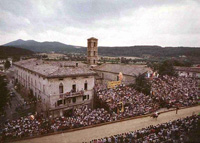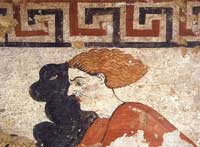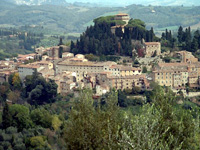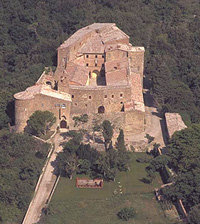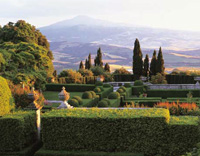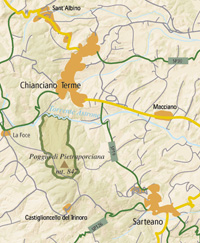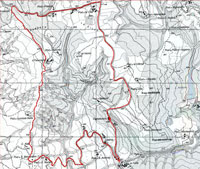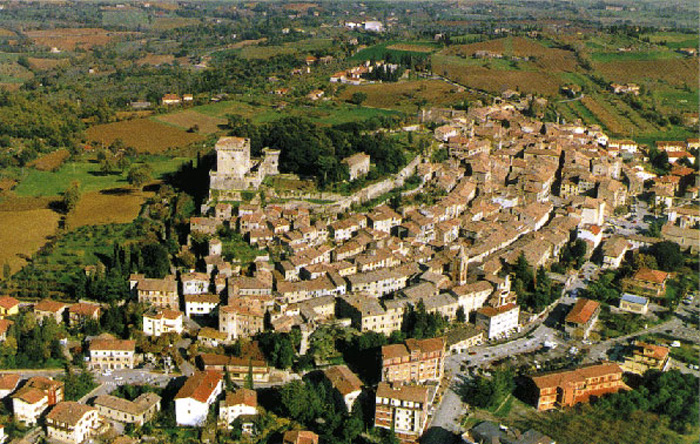 |
|
| I T | Sarteano |
Sarteano |
| Surrounded by and overflowing a double ring of medieval city walls, Sarteano is a small hill town on the ridge of Mount Cetona. The town itself dates from the early Middle Ages but the Etruscans, whose burial sites and tombs are scattered about the town and countryside, inhabited the area much earlier. Sarteano is crowned with the ruins of a castle dating from around 1100. There are a number of ancient churches in the town, including the monumental complex of the ex-convent of Santa Chiara from the order of the Clarisse (1498). A very interesting Etruscan museum is found in one of the Renaissance palazzi built into the city walls; there is a restored and active (with theatrical and musical events) 19th century theatre, Teatro degli Arrischianti, on the main piazza. The annual Giostra del Saracino (see under “Events”) takes place every August 15th.. The annual Giostra del Saracino takes place every August 15th. The climate of the "Tournament" begins when the transport of the earth in the square and the assembly of ther public galeries start. On the 11th August in Bargagli Square te "tratta dei bossoli" happens, preceded by the parade of the "Contrada"; in the square they extract starting order of the five "contrade". After the extraction there are: fireworks, middle ages songs, exibition of the drumers of the flag-wavers. The day before the "Giostra" on the 14th August at three o'clock it starts the historic train with captains, ladies, knights and ox cart. Then there is a show in which they play with the flags, then there is the blessing of horses and at the end the "start". At this point the crowds break out a shout and the players, on horses, compete for the victory by thursts at the ring. The players on their horses have to thread their own spear in a small ring placed on the "Buratto"'s shiled. Every player has got five possibilities, the Contrada, which can thread more rings, is the winner. Events in Tuscany | Giostra del Saracino Comune di Sarteano |
|
||
|
|||
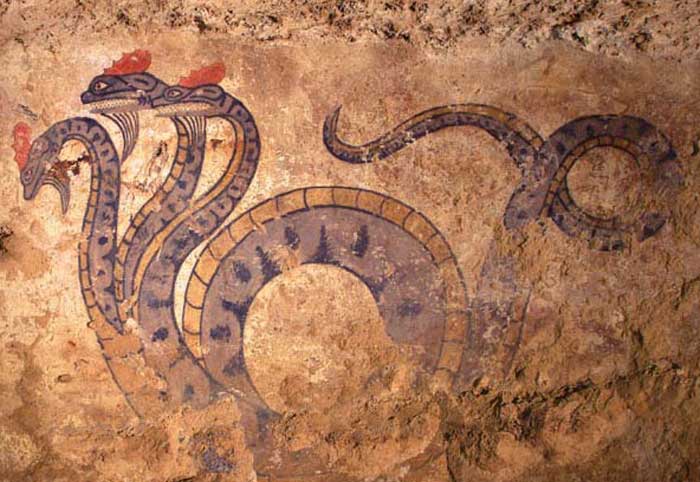 |
|||
Sarteano, Pianacce Necropolis, Botch of the fresco of snake with three heads (Tomba della Quadriga Infernale) |
|||
| The necropolis of Pianacce at Sarteano is one of the best examples of Etruscan wall painting of the 4th century BCE. The necropolis, situated 1 km south-east of Sarteano, was first investigated in 1954 by G. Maetzke who discovered two tombs on the site. One of these was a monumental tomb with a 27 m long dromos and four chambers. They were only part of a vast cemetery area which occupies the entire rocky ridge at the end of the Sartiano plateau facing towards Cetona. The tomb was called of the "Quadriga Infernale" (Infernal Quadriga) because of the disturbing painting representing the god Charun, with his wild fangs and reddish mane, driving a flying chariot. Gallery of pictures | www.archart.it |
|||
 |
|||
The Mountain Monte Cetona seen from Sarteano (north)[1]
|
|||
| To the southeast is found Mount Cetona, Radicofani, visible for miles around, its castle topping the solitary high plateau, the restored (privato) abbey of Spineto dating from 1016, Fonte Vetrianna, an isolated settlement with Etruscan and Medieval beginnings, and the mineral springs of Bagno Santo. The town of Cetona developed on the hillside around the Rocca fortress, containing a square tower and an inner fortress wall. The walls once had three circuits, and today the Rivellino tower, built in the mid-16th century, is the most important remaining trace of the third circuit. The urban structure bears the mark of the wars in the Middle Ages, when Siena and Orvieto battled each other for control of Cetona. Churches in Cetona are the Chiesa di San Michele Arcangelo (1155) and the Chiesa la Collegiata della San Trinita (1475), as well as the Convento di San Francesco (1212) and Convento di Santa Maria a Belverde with frescoes by Cola Petruccioli of Orvieto. The hub of Cetona is Piazza Garibaldi with some buildings of historical interest. To one side of the piazza is the 12th century church of San Michele Arcangelo. It contains a wooden statue of the Madonna delle Grazie dated 1300. In the centre of the piazza is the 16th century church of Santissima Annunziata which contains numerous 17th century paintings and is presently used by the local commune as an exhibition hall. On the opposite side of the piazza stands the eminent 18th century Palazzo Vitelli. Further on, to one side, lies Villa La Vagnola or Palazzo Terrosi as it is otherwise called. The gardens are open to the public at specific times during the summer. At the end of the piazza lies the 16th century Torre del Rivellino, the last remaining vestige of the third wall of defence. The Chiesa la Collegiata della San Trinita was originally built in the 12th-13th century with a single nave in the Romanesque style, an aisle with a small outside portal was added on the left in 1571. The simple interior has some frescoes from the late 1400s, including an Assumption of the Virgin by the school of Pinturicchio (1454-1513). Just outside Cetona are the Convento di San Francesco, begun in 1212 and today the seat of the Comunità di Mondo X, and the Convento di Santa Maria a Belverde, immersed in a woods of centuries-old ilexes and cypresses, under a cliff of travertine. Although it was probably founded sometime around the year 1000, the hermitage as it is today goes back to 1367 and has an original structure composed of three oratories set on two floors. Inside there are 14th-century frescoes by the Orvieto school. Museum of Mount Cetona Prehistory Opened in 1990 and arranged according to educational criteria, the museum collects archaeological finds from Belvedere and other prehistorical settlements in the Mount Cetona area. The material on display dates back to the Palaeolithic period and the Bronze Age and is provided with explanatory boards, relief models, and dioramas. The oldest finds consists of the Mousterian lithic production in the Caves of Gosto and St. Francis. The tour also includes a visit to the Caves of Belvedere. Opening time: Sat. 16-18, Sat. 9.30-12.30, other days on request for groups only (from 16 Oct. to 31 March); Tues. to Sun. 9-13 and 17-19, closed Mon. (from 1 June to 15 Oct.) Piazze, Belverde en Camporsevoli are frazioni of Cetona. Not far from the village of Cetona, in Belverde, you can visit the Parco Archeologico Naturalistico di Belverde, an archaeological and nature park. Ancient traces of human presence have also been found here. The Belverde park hosts 25 prehistoric and Bronze Age caves, such as the San Francesco cave. Grotta di San Francesco, the largest cave on the site, is named after Saint Francis, who is said to have stayed here. You can go through three connected cavities on the path that leads to the Franciscan hermitage of Santa Maria: Antro della Noce, Antro del Poggetto and Tombetta della Strada. Also linked to the park is the prehistory museum, the Museo Civico per la Preistoria del Monte Cetona, which documents the different phases of human settlements in the territory, from the Palaeolithic Age to the end of the Bronze Age, and caves of natural and prehistoric interest. (Parco Archeologico, Naturalistico di Belverde, Strada della Montagna, Belverde - Cetona. Opening time: July-September 30th: 9,30-12,30 and 16-19,30 |
| ||
| On the way to Camporsevoli you find Piazze, a little village developed in the two last centuries. The Fighine castles has a wonderful wiew over the Valdichiana. The Fighine Castle rises in an exceptional strategical position, on the watershed between the valleys of the Paglia and the Chiana streams. Fighine was mentioned for the first time in 1058 in relation to the Parish church of Santa Maria 'de Fighine'. The castle still has its quadrangular original structure topped by tree towers and it houses the Church of St. Michael the Archangel on the inside. The Chiesa Di San Michele Arcangelo has the apse turned to east, according to the ancient tradition, rectangular plant, wooden roof, brickwork paving and two little lateral chapels. In origin it had five altars, today only three. It contains five paintings with images of saints of the Scuola Orvietana and Florentine. Behind the greater altar catch the eye the one of San Michele Archangel, painted by Bonichi of Lucignano in 1750. Also worth a visit is Castiglioncello del Trinoro, a typical medieval village, a small collection of houses around a castle perched on a high ridge overlooking the Orcia Valley. Close to Sarteano, on the hill of Pietraporciana, a protected beech-wood has proved to be of special interest to the Italian botanical society. Comune di Cetona |
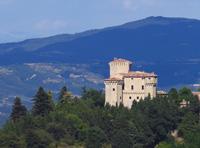 Castello Fighine |
||
Villa La Foce Estate | La Foce - 61, Strada della Vittoria -53042 Chianciano Terme - Siena | www.lafoce.com |
|
|
|
| Walking in the Val d'Orcia | |||
| Pietraporciana Nature Reserve covers the top, the northern side, and part of the southern side of the homonymous hillock (847 m), belonging to the ridge that, between Chianciano Terme and Sarteano, separates Val d’Orcia from Val di Chiana, linking up southwards with Mt. Cetona. An unusual low-altitude beech tree wood grows in the Reserve: it takes advantage of the coolness and humidity dominating the upper part of the northern slope of Poggio di Pietraporciana, at the shadow of the calcareous cliffs outcropping at the top. One of the worthwhile places to see while in the reserve is the tiney hamlet of Castglioncello sul Trinoro, this tiny ‘borgo', which is perched atop a high hill, offers a breath taking panorama of the entire Val d'Orcia. On the northern side of the reserve there is a beautiful woods of beech, a relic of the ice age, which is the host for two species of plant particularly rare in Italy, the Belldonna, with its poisonous blue fruit and the Fusaggine Maggiore (Spindle tree). |
|||
| In the beech tree wood of Pietraporciana | Departure in Sarteano (the road to Castiglioncello), arrival in Sarteano |
|||
| In the Rocconi forest, which lies between the magical world of the Crete of the Val d’Orcia and the neatly organized farm land of the Val di Chiana, there is a stand of secular beech trees which is documented and marked by the Italian Botanical Society. This antique place protects beneath its rock walls, giant beech trees as well as other rare plants, flowers of every kind and lush moss that covers enormous boulders. |
|||
| Terre di Siena in bici |
|||
| Sarteano - Sarteano | The big view over Val d'Orcia |
|||
|
From the piazza of Sarteano you'll take the road in the direction of Chianciano and at the second junction you will turn left towards Castiglioncello del Trinoro. Conitnue on this road, almost completely paved, until Castiglioncello. The Porta Sense from the 1300's and the Romanic church of Sant'Andrea are well worth a visit. From here the dirt road continues downhill towards La Foce, from the gate in front of the villa a climb begins that will take you to pic-nic tables ect. La Crocette. From here, near a gate on your left, you can enter a beautiful centuries old beech grove as well as the Grotta del Bruco (though it's not easy to identify). Once back at the pic-nic area of La Crocette proceed on the main road towards Sarteano. After about 3 km. the dirt roads comes out onto the paved road that connects Sarteano with Castiglioncello del Trinoro which you already covered at the beginnging of the route. The loop ends where it began, in the piazza of Sarteano. |
||
| Villa La Foce | Anello La Foce di Chianciano – Riserva di Lucciola Bella – Palazzone – Castelluccio |
|||
| After visiting Villa La Foce, we start our journey that will take us all the way to Castelluccio. Paved roads before and then white trails, with short deviations to discover the beauty of nature, roads bordered by cypress trees that take us to discover the natural reservoir of Lucciola Bella. Trekking in Toscana | Anello La Foce di Chianciano – Riserva di Lucciola Bella – Palazzone – Castelluccio [Fonte: CAI – Sez. Valdarno Superiore] |
|||
| Villa La Foce | Anello La Foce - Vetriana – Monte Cetona |
|||
| Monte Cetona (1148 m) is in the south eastern section of Tuscany, near the border with Umbria. Trekking in Toscana | Anello La Foce to Vetriana and Monte Cetona |
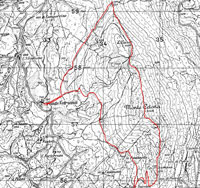 |
||
Villa La Foce Estate | La Foce - 61, Strada della Vittoria -53042 Chianciano Terme - Siena | www.lafoce.com Walking and trekking in Tuscany | Walking in the Val d'Orcia Tarquinia | The Necropolises of Tarquinia and Cerveteri |
|||
The Abbazia di Spineto |
|||
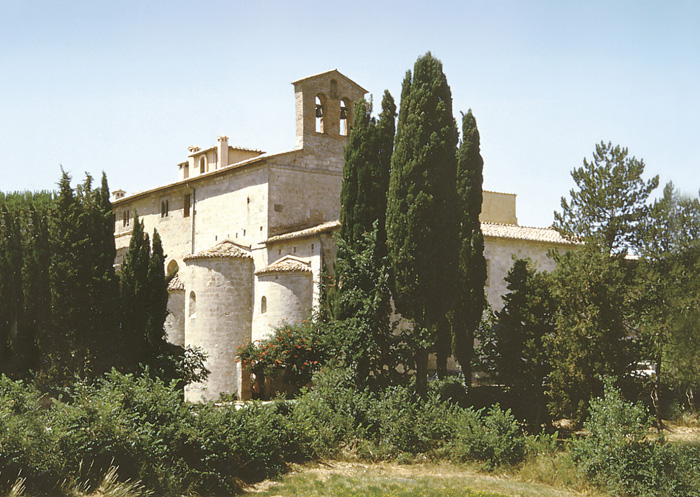 |
|||
The Abbazia di Spineto |
|||
| Abbazia di Spineto (Tenuta or estate di Spineto) was founded by a legacy of Willa, widow of the count Pepone I of Sarteano. She gave the land and the wood of Spineto, the hill of Moaine and the near lands as a present to Rodolfo of the Abbey San Salvatore on Mount Amiata. Her intent was to assure a continuous and regular practise of religious rites which secular priests could not perform prior. Monk Rodolfo acted immediately to build the Abbey and organize the religious life of the monks. That was the age of monachesimo: monestaries and abbeys flourished in every region of the peninsula. At different times, the Abbey found itself under the protection of Orvieto, the Republic of Siena and the Ducato of Florence. It has been a hospital and finally in 1627 was entrusted to the Cistercian Order by Pope Urbano VIII. The present owners bought the Abbey in 1989 and began a long period of restoration over fourteen years resulting in the complete recovery of the monastic building. The ancient walls have been restored, the spaces have been reinvented for contemporary demands. The abbey is not open to the public. |
|||
|
|
|
| Restaurants in Sarteano La Locanda dei Tintori, Piazza Bargagli, 26, Sarteano, 0578/267096 Restaurants in Cetano OSTERIA VECCHIA, Via Cherubini, 11, Cetona, 0578/239040 - Closed Tuesday
|
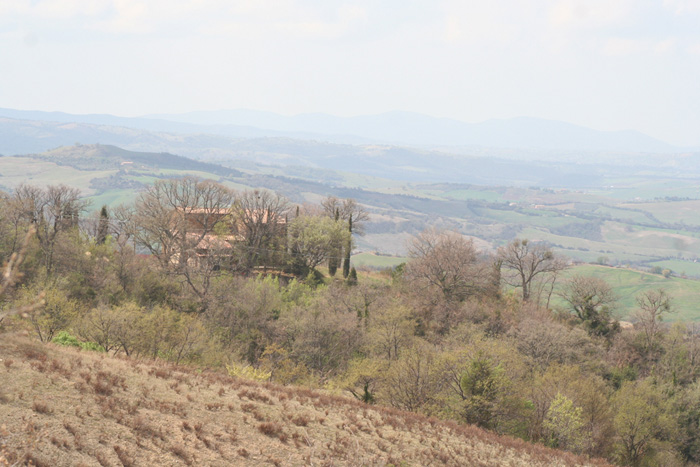 |
Podere Santa Pia sits on a hill overlooking the Maremma countryside in southern Tuscany,
and it offers absolutely everything that any of your senses would want of a Tuscan vacation
|


